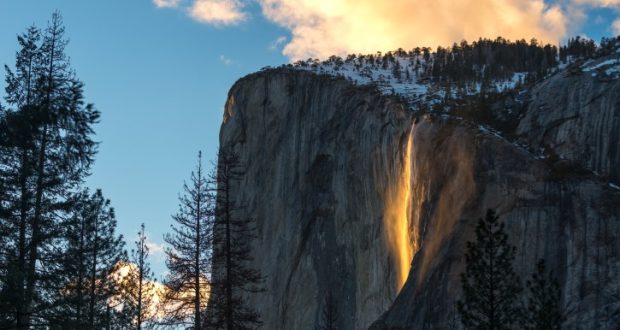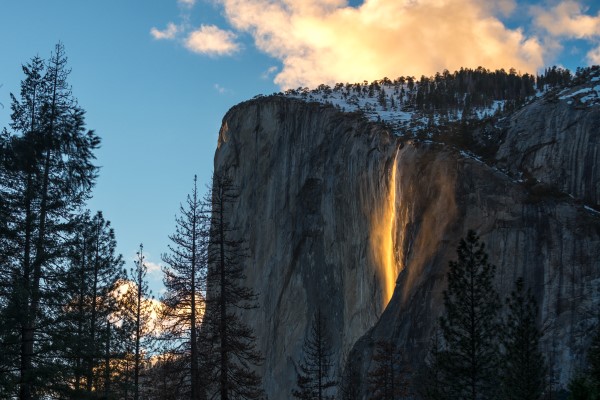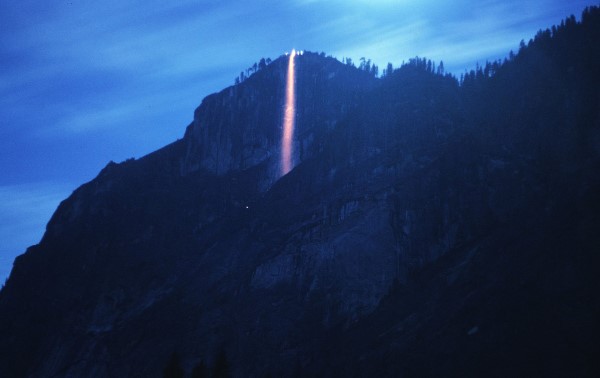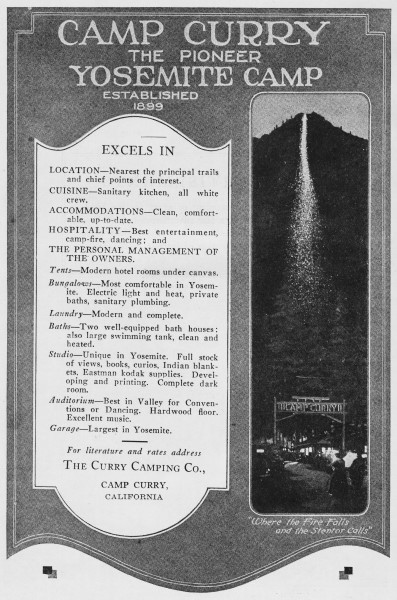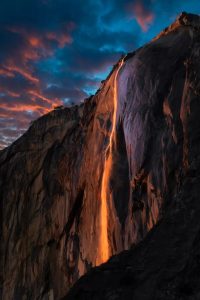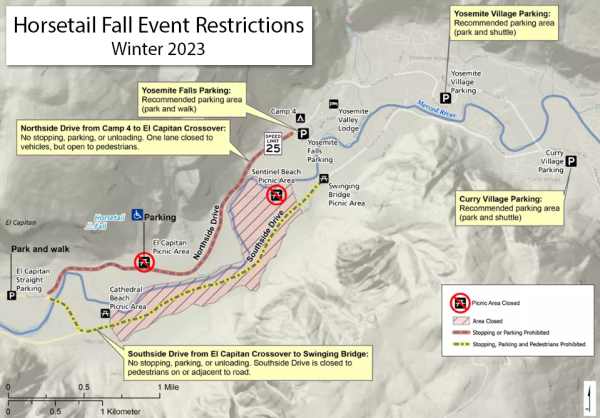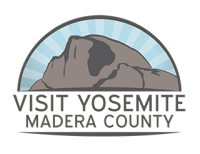YOSEMITE NATIONAL PARK — The sight of a ribbon of “fire” off a cliffside is something you would imagine seeing in a Lord of the Rings film. And as such, the “legend” of the annual formation of the Horsetail Fall as Yosemite’s natural Firefall has become a global phenomenon. With that being said, here’s the scoop on Horsetail Fall.
For those wanting to jump right to what’s special for 2023 (restrictions, etc…), click here.
It’s Horsetail Fall Not Horsetail Falls
For those in the know, hearing people call Horsetail Fall plural is like hearing nails on a chalkboard. It’s just wrong. How come? With Yosemite being the showcase of waterfalls, the definition is important. As nouns, the difference between a waterfall versus waterfalls is that if the river or creek flows off a cliffside in one unique movement or drop, it’s considered a “fall.” While “falls,” also called “cascades,” generally means there are several distinct drops or falls in a particular section of a stream.
A great example to illustrate the differences – Yosemite Falls which is actually made up for three sections; Upper Yosemite Fall (a single drop), the middle Cascades, and Lower Yosemite Fall (another single drop).
How Did Yosemite’s Natural Firefall Get Global Fame
While the natural Firefall event of the Horsetail Fall that happens in February has been around for as long as Yosemite has existed, no one really knew about it until Galen Rowell took the first-known color photograph in 1973 for National Geographic (Interesting aside – in or around 1952 Ansel Adams did capture what was known at that time as El Capitan Fall. But since it was black and white, the unique colorful and fiery event we know of today was not conveyed). Now with the advent of digital photography and social media, this helped propel the ephemeral event into stardom.
The Original Firefall At Glacier Point
For almost a century nightly bonfires created at Glacier Point that were pushed over the cliffs toward spectators located in Curry Village below. The idea originated inadvertently in 1872 with James McCauley, the owner of the The Mountain House at Glacier Point. Every night during the summer, he would build a campfire to entertain his guests.
To extinguish the fire, he would kick the smoldering embers over the cliff. It didn’t take long for the visitors 3000 feet down below in Yosemite Valley who saw the embers tumbling down the cliff to request the Yosemite Valley Lodge to see the “Firefall.” And thus, the Yosemite Firefall was born.
The “natural” Firefall, is much more natural and of course, rare, depending on a good stream of water flowing over Horsetail Fall, a clear sky and the right light hitting the cliffs at the right time to produce the desired effect.
Over 25 years, McCauley kept this tradition until he was evicted from Glacier Point. As years went by, the Yosemite Valley Hotel owner, David Curry, kept hearing visitors fondly remembering that activity. So, he brought it back for special occasions. This continued until 1913 when the park service banned it due to a possible leasing dispute with Mr. Curry. Reinstated in 1917, the display continued again with a break during WWII and was finally ended in 1968 by the director of the National Park Service, George B. Hartzog. His thought and rightly so was that it was an unnatural spectacle more fitting for Disneyland instead of a National Park.
While long gone, its memory is still deeply embedded in Yosemite’s history. It’s as if you can still hear the master of ceremonies, the Stentor, in Camp Curry bellowing out the following exchange with the firemaster at Glacier Point…
“Hello, Glacier Point!”
“Hello, Camp Curry!”
“Is the fire ready?”
“The fire is ready!”
“Let the Fire Fall!”
“The Fire Falls!”
The “Perfect Storm” Must Happen
Like many natural phenomena, everything needs to align for it to become a reality. First, the setting sun must be at the right angle which happens to be around the second week of February.
Second, the snowpack needs to be deep enough to generate enough water flow over El Capitan.
Third, the sky needs to be crystal clear. We’re talking not a single cloud or haze even near the horizon. And if everything aligns for that perfect moment, it lasts for only a few, fleeting minutes.
With such a short time window and so many elements to intersect, it’s a tough sight to see. As we said above, the popularity of this event has skyrocketed in recent years. From once only a few keen observers to now hundreds and possibly thousands of spectators for 2022. If you are traveling to attempt seeing this attraction, be aware of the new rules.
2023 Rules To See Horsetail Fall
The event continues to be increasingly popular these last few years. Crowds have burgeoned with hundreds or thousands of intrepid viewers gathering at the viewing areas on some days. Both safety issues and damage around viewing areas have occurred as a result.
To address this, Yosemite will again put viewing and parking restrictions in place in addition to requiring reservations to enter the park for three weekends in February. The restrictions will be in effect from February 10 through 27 and reservations will be required for entry to the park for the following dates:
- February 10-12
- February 17-19
- February 24-26
Reservations will also be required for Camp 4, Wawona and the Hodgdon Meadow Campgrounds from Feb 1 – 28 (these normally operate on a first-come, first-served basis throughout the month of February).
Specifics regarding parking and viewing restrictions from the park:
To view Horsetail Fall, park at Yosemite Falls parking (just west of Yosemite Valley Lodge) and walk 1.5 miles (each way) to the viewing area near El Capitan Picnic Area. If this parking is full, park at Yosemite Village or Curry Village and use the free shuttle (which stops at both) to get to Yosemite Falls parking/Yosemite Valley Lodge. In addition to the regular shuttle, an express shuttle will be operating between Yosemite Village and the Yosemite Falls parking/Yosemite Valley Lodge.
Vault toilets, along with trash and recycling dumpsters, are available at the El Capitan Picnic Area. Northside Drive will have one lane closed to vehicles so pedestrians can walk on the road between the viewing area and Yosemite Falls parking. Bring warm clothes and a headlamp or flashlight. Parking, stopping, or unloading passengers will be prohibited between Camp 4 and El Capitan Crossover. Vehicles displaying a disability placard will be allowed to drive to El Capitan Picnic Area and park in turnouts on the north side of Northside Drive. On busy weekends, Northside Drive may close completely for about a half hour immediately after sunset.
Southside Drive will be open to vehicles, but parking, stopping, and unloading passengers will be prohibited between El Capitan Crossover to Swinging Bridge Picnic Area. Pedestrians will also be prohibited from traveling on or adjacent to the road in this area. From Cathedral Beach Picnic Area to Sentinel Beach Picnic Area, the area between the road and the Merced River (including the river) will also be closed to all entry.
El Capitan Crossover (the road connecting Northside and Southside Drives near El Capitan) will be open to vehicles, but parking, stopping, and unloading passengers will be prohibited.
Just like anything in this world that’s worth something, this year you’ll have to earn it. To see this display, you may have to hike 3 – 4 miles (round trip) to see it. The closest parking will be at Yosemite Falls Parking Area near the Yosemite Valley Lodge and on Northside Drive along El Capitan Straight.
As anyone that’s visited the mountains before knows, even if it’s warm mid-day, expect the temps to drop as the sun starts to set. So, be sure to come early, bring warm clothes, boots, and a headlamp or flashlight.
You’ll be grateful.
Like what you see? Check out other travel stories/blog posts as well as itineraries for more ideas!

